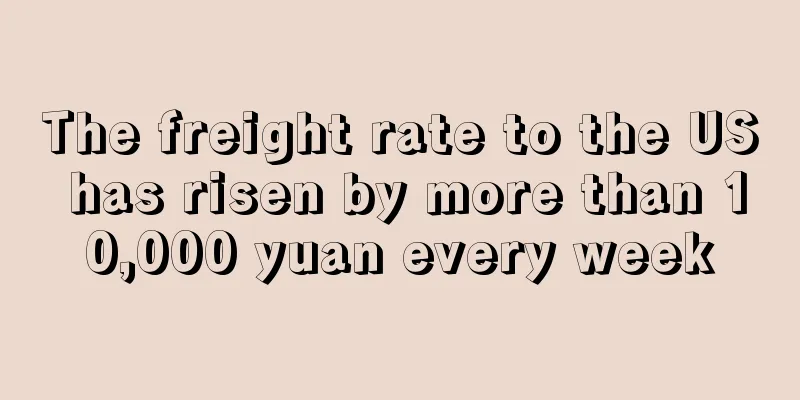The freight rate to the US has risen by more than 10,000 yuan every week

|
Ocean freight rates have been rising all the way, and have now experienced a continuous increase for 12 consecutive weeks. Freight rates on the US route have exceeded the 10,000 yuan mark, and there is still no sign of a decline in the future.
"The prices are going up every week. I feel pressured but there is nothing I can do. I can't just stop shipping, and I can't ship less because of price increases, because I don't know whether the prices will go up or down in the future!" lamented an Amazon seller.
Freight to the US exceeds 10,000 yuan
The upward momentum of the global container shipping market continues . According to the latest Shanghai Containerized Freight Index (SCFI) on the 28th, the weekly increase was as high as 6.87% to 3714.32 points, and it has been rising for 12 consecutive weeks.
The tension in the Red Sea, congestion and strikes at European and American ports and other factors have driven the global shipping market freight rates to continue to rise . Recently, the European and American routes have been crazy, with European routes rising by 12.5% and breaking through the $5,000/TEU mark; the US East Coast route has risen by 12.05% and broken through the $9,000/FEU mark.
According to the latest news from freight forwarding companies, freight rates will continue to rise in July, based on the price increases in May and June. In July, due to the dock workers' strike crisis , the freight rate on the US East Coast route increased by US$2,000, and the freight rate on the US West Coast and European routes increased by US$1,000-1,200 per container.
The freight rate for the US West Coast route will increase from US$7,100-7,400 to US$8,100-8,400, and the US East Coast route will increase from US$8,300-8,400 to US$10,300-10,400 , making the US East Coast the first route with a freight rate of over 10,000 yuan. The European route will increase from US$7,500 to US$8,500 .
This surge has had a huge impact on cross-border sellers. After experiencing continuous increases in freight rates, the sellers’ already immune nerves were again aroused when they saw the US line break through 10,000 yuan!
Many Amazon sellers feel that the platform's warehousing and configuration fees have increased freight costs. As ocean freight rates continue to rise, costs have increased significantly and profits have been greatly reduced. After working hard for half a year, they feel like they are working for Amazon and shipping companies when they look at the profits.
One seller said: "Some of my peers who are not selling well will reduce shipments and wait for the freight rates to drop. I ship on demand, but I can't do anything about the weekly freight rate increases. After all, this is the current market situation."
At present, the Red Sea conflict, which has exacerbated the rise in global shipping costs, has not subsided. On the 28th, the Houthi armed forces claimed to have carried out a series of attacks on multiple ships in the Mediterranean and Red Sea regions, including a Maersk ship.
Due to the ongoing impact of the Red Sea crisis, shipping companies are imposing or planning to temporarily impose more high surcharges. Maersk's recent announcement mentioned the industry-wide shortage of container equipment and space, as well as the additional costs and high demand caused by increased customer demand. In order to continue to meet customer needs, certain surcharges have to be temporarily increased. Specifically, from July 9, the peak season surcharges from Far East Asia to Northern Europe will be increased to US$2,000 for small containers and US$4,000 for large containers.
Container freight rates from Asia to the United States and Europe are said to have tripled since the beginning of 2024.
“China’s seaborne exports of goods related to e-commerce, electric vehicles and renewable energy increased significantly in May,” said DiMelco, a freight forwarder in Asia.
The Heinetta freight platform said that cargo volumes from Asia and Singapore to the U.S. East Coast were at their highest level since September 2022, while volumes into the U.S. West Coast were at their highest level since August 2022.
Freight rates may stabilize, and a decline is unlikely
As shipping prices continue to soar , cross -border sellers are under increasing pressure . One seller asked: " Why are shipping prices rising every week ? When will they fall back?"
According to freight forwarders in the industry, the reasons for the increase in freight rates include the following: 1. The Red Sea crisis has lengthened the voyage , causing a lot of congestion and leading to tight shipping capacity. Shipping companies have been raising prices to make up for the increase in operating costs ; 2. Under pressure from rising freight rates, many people choose to ship in advance, bringing the peak season forward to May ; 3. Sellers are preparing for the July promotions on major platforms such as Amazon and Walmart, and the demand for shipments has increased ; 4. Affected by the increased tariffs, a large number of affected companies are rushing to ship in large quantities before the tariffs take effect ; 5. Major ports around the world are congested and there is a shortage of containers; 6. Scalpers have further pushed up freight rates .
The subsequent freight rate trend will depend on the above factors as well as other current conditions.
As Houthi attacks on the Red Sea continue and some shippers want to avoid U.S. import tariffs, congestion at Asian ports has intensified, reaching levels not seen since the pandemic.
According to a report by the maritime data company, as of mid-June, ships with a total capacity of more than 2.4 million twenty-foot equivalent units were waiting at anchor, with 60% of the ships anchored in Asia. One of the worst affected Asian ports is Singapore, the world's second largest container port.
Average unloadings in Singapore rose 22% between January and May, according to data from the Maritime and Port Authority of Singapore . Some ships are skipping Singapore to avoid congestion , shifting pressure to other ports, with waiting times rising at Chinese ports, with Shanghai and Qingdao seeing the longest delays.
Some industry insiders believe that bottlenecks at Chinese ports are partly due to U.S. importers' rush to buy Chinese steel and medical products , on which tariffs will rise sharply from August 1 .
Tariffs on some Chinese imports to the United States will increase starting August 1. The new tariffs will affect goods such as electric vehicle batteries, computer chips and medical products.
Some research firms say this year's peak shipping season, which arrived earlier than expected, has also exacerbated congestion. Data provider Descartes said container imports at the 10 largest U.S. seaports rose 12% in May, the second-highest monthly volume since January 2023. U.S. consumers are spending more than last year, and retailers are stocking up to meet demand.
A series of factors combined make it unlikely that ocean freight rates will fall back, and there is still a trend of continued rise. Many sellers are worried about whether they will return to the highs during the epidemic. Industry insiders believe that freight rates will not return to the level before the epidemic.
First, the US issued $5 trillion in subsidies during the pandemic, which greatly stimulated people's consumption. Everyone stayed at home and made large purchases, and many commodities were in short supply. The lack of dock workers due to the pandemic caused port congestion, which pushed up freight rates.
Secondly, the current consumption habits of Europeans and Americans have changed compared to those during the epidemic. With the reduction of income and greater economic pressure, many people buy rationally and reduce spending. The rationalization of consumption direction also makes it impossible for freight rates to soar;
Finally, the congestion at major ports around the world and dock workers' strikes are very different from those during the epidemic, and the reduction in capacity is also different, and the market will not repeat the same mistakes.
Based on the fact that the peak season has been brought forward and the overall trend on the demand side, freight rates on some routes will stabilize in mid-July. Ocean Freight US Line |
<<: It broke into BSR in 30 days and broke through the siege with its hit product!
Recommend
What is TotallitiX? TotallitiX Review, Features
TotallitiX is a market tracker for Amazon that can...
Temu encounters obstacles overseas again, another region will take action on tariffs
Last week, Temu was officially launched in Brazil...
The UK strike continues to ferment, and small and medium-sized sellers suffer heavy losses
According to foreign media reports, large-scale s...
Tmall's Double 11 transaction volume reached 540.3 billion yuan, with growth quality and social value becoming core indicators
At 0:00 on November 12, 2021, Tmall’s Double 11 t...
Chinese-style skiing on TikTok sparks heated discussion, Winter Olympics heats up winter sports
As the Winter Olympics approaches, young people i...
Amazon paid more than 600 million pounds in taxes a year and received a "small" tax relief
Amazon's profits surged 60% to £204 million (...
At 150 euros per order, Germany has the highest average online order spend in Europe
Recently, a report released by Sendcloud and Niel...
Amazon India ends "SBD activity", expects social e-commerce sales in the United States to reach US$36.6 billion this year
Amazon India ends "SBD campaign" On Jul...
Onion prices surge 346%, South Korea's prices soar to 10-year high
Since February 2011 , prices of agricultural and ...
What is AdMob? AdMob Review, Features
AdMob is a mobile advertising platform that helps ...
EU parcel volumes to UK plunge 51% after Brexit
According to research by shipping platform Sendcl...
What is domolds? domolds Review, Features
Domolds is a manufacturer specializing in the res...
What is KJDS? KJDS Review, Features
Yueyu.com (KJDS) is a cross-border export distribu...
What is Shanghai GEEKO? Shanghai GEEKO Review, Features
Shanghai Jigao is a cross-border B2C Internet comp...
What is longer? longer Review, Features
Founded in June 2014 by a team of Chinese national...









